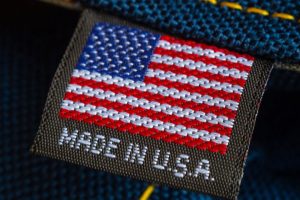 This is the Kodak Tourist, made by the Eastman Kodak Corporation between the years 1948 and 1951. It is a medium format folding camera that shoots 6cm x 9cm images on 620 roll film. Despite it’s humble appearance, the Tourist series was somewhat of an upscale camera, optionally featuring Kodak’s best Anaston and Anastar lenses and Kodamatic and Synchro-Rapid 800 Shutters. The double hinged film door was removable to support an 828 film back for shooting small format film. A later version called the Tourist II was the same camera, but with a different viewfinder with projected frame lines. The Tourist series was a popular alternative to more expensive German folding cameras of the era.
This is the Kodak Tourist, made by the Eastman Kodak Corporation between the years 1948 and 1951. It is a medium format folding camera that shoots 6cm x 9cm images on 620 roll film. Despite it’s humble appearance, the Tourist series was somewhat of an upscale camera, optionally featuring Kodak’s best Anaston and Anastar lenses and Kodamatic and Synchro-Rapid 800 Shutters. The double hinged film door was removable to support an 828 film back for shooting small format film. A later version called the Tourist II was the same camera, but with a different viewfinder with projected frame lines. The Tourist series was a popular alternative to more expensive German folding cameras of the era.
Film Type: 620 Roll Film (eight 6cm x 9cm exposures per roll, varies with accessory kit)
Lens: 105mm f/4.5 Kodak Anaston coated 4-elements
Focus: 3.5 feet to Infinity
Viewfinder: Scale Focus Optical
Shutter: Flash Kodamatic Leaf
Speeds: T, B, 1/10 – 1/200 seconds
Exposure Meter: None
Battery: None
Flash Mount: Coldshoe and M and X Flash Sync, if hotshoe, flash sync speed
Weight: 810 grams (w/ Anaston), 834 grams (w/ Anastar)
Manual: http://www.cameramanuals.org/kodak_pdf/kodak_tourist.pdf
How these ratings work |
The Kodak Tourist was a rather well featured 6×9 folding camera that offered a lot of bang for the buck when first released. It was available with a wide variety of lens and shutter combinations with the top of the line model featuring an excellent 4-element Kodak Anastar lens and Synchro-Rapid 800 shutter. The Tourist series was quite popular, staying in production for over a decade. When equipped with one of the f/4.5 lenses, it produces excellent results making it a bargain in the collector’s market today. | ||||||
| Images | Handling | Features | Viewfinder | Feel & Beauty | History | Age | |
| 2 | 1 | 1 | 1 | 2 | 1 | 30% | |
| Bonus | +1 for overall excellence at a bargain price | ||||||
| Final Score | 11.4 | ||||||
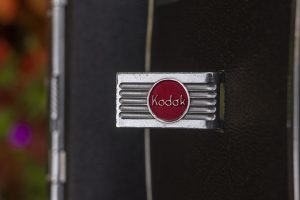
History
The Eastman Kodak Corporation has a long history of making folding cameras. If I had a nickel for every estate sale I’ve been to with at least one folding Kodak, I’d have…a lot of nickels. Although there are some exceptions, many of these early 20th century Kodak folders were quite basic. Many had meniscus or doublet lenses with basic single speed shutters.
While many collectors often thumb their noses at these early folders, it’s important to remember that Kodak always has been a “film first” company. From the very first 1888 Kodak to the first Brownies, VP Kodaks, and even the Retina, Kodak produced cameras to generate more potential customers for their film.

Kodak’s reputation as a maker of quality cameras was often quite low as you really don’t need a state of the art precision instrument to make a photograph. The thing is, Kodak would on occasion release a couple really terrific models alongside their run of the mill models. Such is the case of the Kodak Tourist.
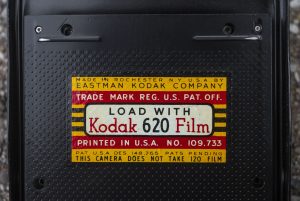
First released in 1948, the Kodak Tourist was a medium format folding camera that shot 6cm x 9cm images on their 620 format of roll film. Kodak’s 620 film uses the exact same film stock as regular 120 film, except on thinner spools. This fact alone often turns off many collectors as most cameras designed for 620 film cannot use regular 120 without some kind of modification or respooling.
I’ve never had much of an issue with this, as I find respooling 120 onto a 620 spool to be quite easy and something I can do in less than 2 minutes in a film changing bag. Some people like to try to modify plastic 120 spools by either sanding them down or using a nail clipper to make them smaller. Some models like the Kodak Medalist and Chevron have such tight film compartments, even filing down a plastic 120 spool won’t work as these cameras are extremely intolerant of anything but a genuine metal 620 spool. While it’s possible to have some success doing this on other 620 cameras, the risk of a piece of plastic falling off inside the camera damaging it, or even damaging the film is too great. I much prefer to respool the film. If you’d like to try this yourself, the Film Photography Project made a really great video showing the same method I use.
The Tourist occupied the lower to middle end of the market below their Kodak Monitor series and was a replacement for the Vigilant Junior camera which was produced between 1940 and 1948. They were generally well made cameras with a die cast aluminum body and covered in Kodak’s own synthetic leather called Kodalur.
The release of the Tourist coincided with an dramatic increase in popularity of Kodachrome slide film. Originally released in both 35mm and 828 formats in 1936, Kodachrome’s popularity surged in the years after the war as a new generation of Americans were settling down, starting families, and wanting to capture precious moments in color. As a result, Kodak tried to push Kodachrome on as many people as possible, even those who owned medium format cameras, so they created a Tourist 828 adapter kit, which added a 28mm x 40mm mask in the film compartment and replaced the Tourist’s rear door with an 828 specific one. The 828 kit is compatible with all Tourist models with any of the f/6.3 or f/4.5 lenses, but not the f/8.8 or f/12.5 models.
In order to replace the door on the Tourist, there are hinge releases on both sides of the camera, which has the added benefit of allowing any door connected to the Tourist to open from the left or the right. This is very convenient as it simplifies film loading by giving the photographer a choice of which side they want to start on.
If you weren’t a fan of 828 film but still wanted something smaller than a 6×9 exposure, there were optional masks for 6×6 and 6×4.5 that could be inserted in the film compartment as well.
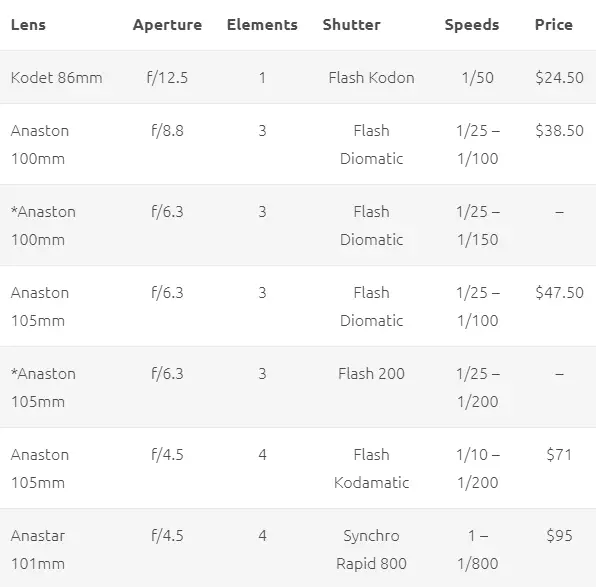
The Tourist had a wide range of lens and shutter combinations from the single element Kodet 86mm f/12.5 with single speed Flash Kodon shutter to the Tessar based Anastar 101mm f/4.5 with Synchro-Rapid 800 shutter, with prices ranging from $24.50 to $95 depending on model. These prices compare to $260 and $1000 today.
The Synchro-Rapid 800 shutter was based on the same shutter Kodak used in their Kodak Chevron camera. With it’s 1/800 top shutter speed, it was the fastest medium format leaf shutter at the time of it’s release.
How Kodak was able to accomplish such a fast shutter speed was by using a unique design with two sets of shutter blades. Unlike most leaf shutters in which a primary set of blades open all the way and change directions to close for each exposure, the Synchro-Rapid 800’s shutter only rotates in one direction for each exposure, cutting the length of time that it needs to work in half.
This has a side effect of requiring the shutter blades to move in the opposite direction when cocking the shutter, which would expose the film as the shutter has to open again, but backwards. To prevent light from passing through to the film, a second set of shutter blades stays closed while cocking the shutter, so as not to expose the film. This second set of shutter blades is not used for exposure, and merely has to get out of the way during normal exposure, but stay closed when cocking the shutter.
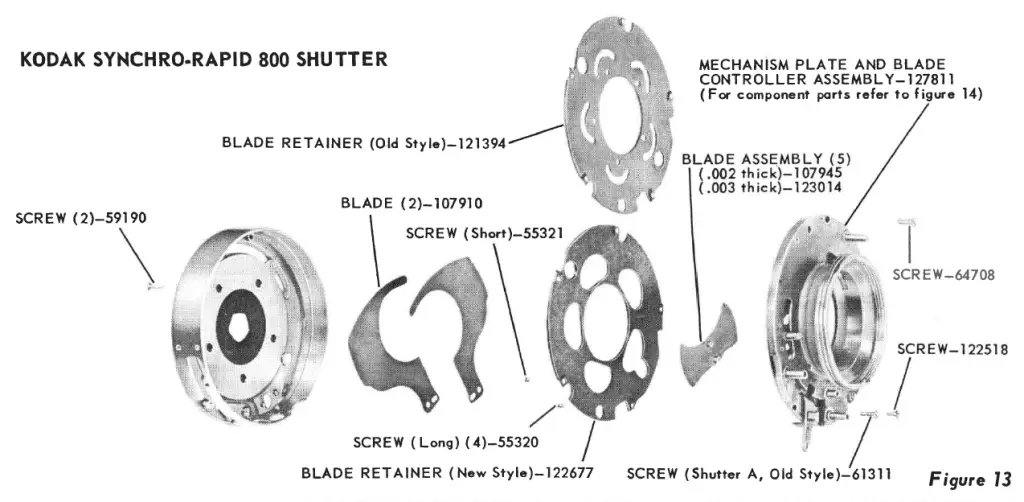
While this proved to be an effective way to achieve such fast shutter speeds, the additional complexity caused the shutter to develop reliability problems. Many cameras like the Tourist and Chevron that feature this shutter exhibit problems today.
In 1951, an updated model called the Tourist II would make its debut with a revised viewfinder that Kodak referred to as the Scopesight viewfinder in which there was a projected frame line in the viewfinder to help with composition. Earlier versions of the Tourist II had the name plate on the very top of the top plate, and later versions had it facing forward in attractive red lettering.
There’s no telling how many Tourists were sold, but the whole series was produced for 10 years and as I type this, there were 199 auctions for “Kodak Tourist Camera” currently for sale on eBay which suggest that quite a few were sold.
Today, there doesn’t seem to be much of a collector’s market for the Tourist, and frankly, I can see why. Even though the f/4.5 models are quite capable cameras, the overwhelming majority of the ones out there are the lower end f/12.5 and f/8.8 models. Kodak’s reputation in the folding camera segment doesn’t help either. Sure, the company had quality medium format cameras like the Medalist and Chevron, but very few people in the market for a mid century medium format camera would consider the Tourist. But that’s where this camera’s biggest strength is. These things often sell for very little, which is probably why I’ve come across so many of them. The Kodak Tourist is not only a feature rich camera, but also capable of wonderful results.
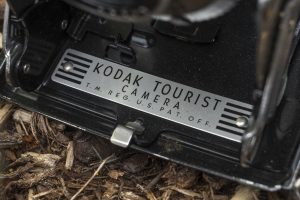
My Thoughts
In this hobby, sometimes cameras come, sometimes cameras go. In the case of the Kodak Tourist, it would take the 4th Tourist to come across my desk before I found one that I was willing and able to shoot a roll of film through.
The first, was one of the lower end models that came to me in early 2015 when I first started collecting and simply had no interest in as I hadn’t yet ventured into the world of mid century Kodak 620 folders.
The second was an Anaston f/4.5 equipped one that I had an interest in shooting, but it had some major issues. One of the folding struts was somehow missing, and the shutter was completely seized. I thought I could still shoot it with the missing strut if I could at least get the shutter working, but Kodak in their infinite wisdom did not use a locking ring like pretty much every other maker of folding cameras, instead the shutter was riveted to the lens plate, and my attempt at getting it out, made it worse.
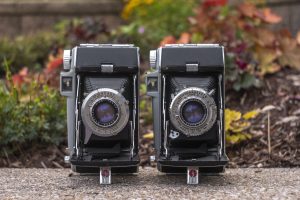
The third, was the top of the line Anastar version with the Synchro Rapid 800 shutter, but it too had a malfunctioning shutter.
Finally, the fourth, which is the one being reviewed here with the Anaston f/4.5 lens and Flash Kodamatic shutter. Although not the top of the line lens and shutter combination, it was still a highly regarded performer that I had high hopes for.
Upon holding each of the final three Tourists, it is clearly evident that this is not just some cheap Kodak folder. The Bakelite (or whatever it is) top plate I think is what cheapens the look of the camera, but despite any preconceived notions I had, the Tourist felt like a pretty decent camera in my hands.
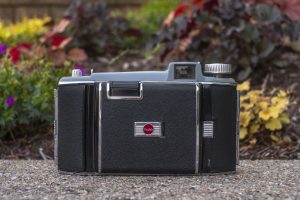
Folded up, the camera is nicely detailed with chrome trim, and a durable synthetic body covering that doesn’t show scratches, cracks, or Zeiss bumps like other cameras have. Of the four Tourists I came across, none showed any signs of body covering peeling or missing, suggesting that the Kodalur covering was up to the task. The camera weighs 810 grams (~1.8 lbs) with the Anaston lens, which is heavier than both the Voigtländer Rollfilm at 544 grams and Kodak No.1 Autographic Special at 771 grams.
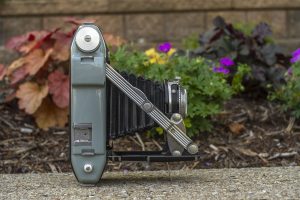
The top plate features the film advance knob, accessory shoe, two strap lugs, and a small knob that at first appears to do nothing, but is actually a release for the spool centering pin for loading in a new roll of film into the camera. I’ll get to this later.
Another notable characteristic of the top panel is it’s color. The plastic panel has some chameleon characteristics as it seems to change color depending on the lighting. In each of these beauty pics, it’s color seems to wander between a teal green, turquoise blue, and gray. I had half a mind to color correct the various photos in this article to make them all consistent, but decided to leave them as is, so you can appreciate it’s multi-pigment-ness!
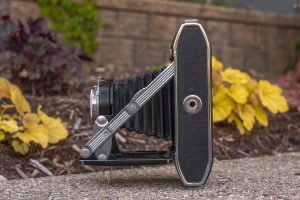
The bottom of the camera lacks the plastic from the top and is just a flat piece of metal covered in Kodalur and has a centrally located 1/4″ tripod socket.
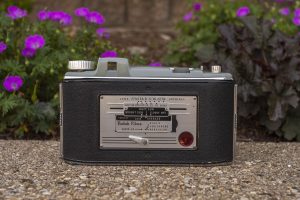
The standard back that comes with all f/6.3 and f/4.5 Tourists has a sliding exposure calculator, similar to the one that Kodak used on other cameras of the era like the Signet 35. Below the exposure calculator is the red window for viewing the exposure numbers on the back of the film paper. To the left of the red window is a spring tensioned lever that opens and closes a metal door protecting the red window from excess light. You need to press down and hold the lever while advancing the film in order to see the numbers.
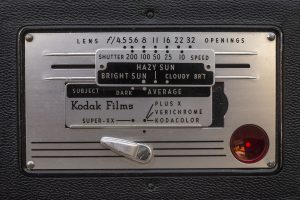
To use the exposure calculator, there are two sliders, one for the type of film you have in the camera, and the other for changing the lighting conditions. This being a Kodak camera designed in the late 1940s, they only give you film options for the 4 types of Kodak films that were available in 620 at the time.
I would set the calculator like I have in the image to the right if I were shooting Kodak Plus-X of an average subject in bright sunlight. It recommends shutter speed and f/stop combinations of 1/200 @ f/5.6, 1/100 @ f/8, 1/50 @ f/11, and 1/25 @ f/16, all of which would give proper exposure.
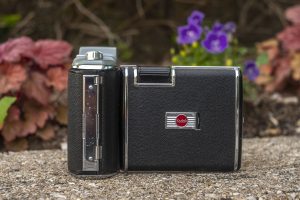
Removing the film door requires sliding a door lock on both sides of the camera. Remember, the Tourist allows you to swing open the door to the left or right, or remove it altogether. Whichever you choose, you need to unlock the hinge. In the image to the left, you can also see the large shutter release button on the front door of the camera.
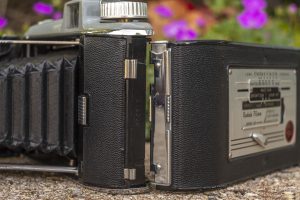
The image to the right shows the camera’s right hinge separated from the body. When you are ready to close the door, you must make sure the two sliding pins are in their correct position to hold the door securely shut. The Tourist predates the use of foam light seals, so there was no degraded seals that I had to replace.
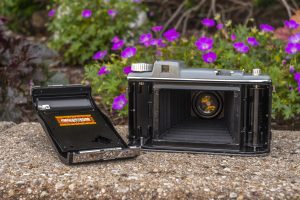
With the film back off the camera, loading the camera is mostly easy. I say “mostly” because due to the nature of Kodak’s 620 film, the spools are very narrow. Kodak intentionally made tight film compartments in their mid-century 620 cameras to discourage people from using standard 120 film with it’s large spools in their cameras.
Film travels from right to left, and in order to remove an old spool on the right side and insert a new spool, you must first release the spool centering pin, which is connected to the smaller knob on the top plate of the camera which I mentioned earlier. To do this, you must first press down on the small knob on top of the camera and rotate it clockwise a quarter turn. Once you’ve done this, the pin will pop up, allowing you to easily remove and install a new spool. Without doing this, removing the old spool will be impossible, and any attempt to force it out will likely damage the camera.
For the take up spool, the winding knob must also be pulled up to give room to insert a spool on this side, but it doesn’t require any unusual steps. Once you have a new roll of film loaded, make sure to reset the film centering spool and then close the door, making sure that the latches on both side of the camera are secure.
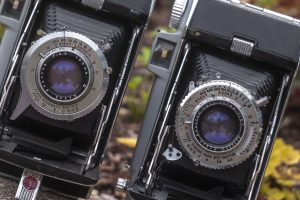
All versions of the Kodak Tourist use rim set leaf shutters with front unit focusing rings which work exactly like every other shutter of this style. Shutter speed is changed with a dial around the perimeter of the shutter, and f/stops are selected by moving a small lever nearest the door. The Anaston equipped models have shutter speeds from 1/10 to 1/200, plus B and T, and a self timer. The Anastar versions have shutter speeds from 1 to 1/800, plus B, no self timer, but an adjustable M/F/X flash synchronizer.
The Tourist does not have a self cocking shutter, so you must do this by moving the cocking lever above the shutter speed scale as far as it will go. It also lacks double image prevention, so do not cock the shutter until after you’ve advanced the film and are ready to make your exposure.
Finally, the viewfinder, although basic and offering no information about the status of the camera, is large and bright making composition of the large 6×9 frame a snap. With the 6×6 and 6×4.5 baffle kit would have included a mask that clips on over the front viewfinder window to approximate the smaller frame, but I did not have access to this kit.
Like other mid century Kodak cameras, Kodak’s reputation as a “film first” company didn’t do their mid-tier cameras like the Tourist any favors. While the series was a good seller, their value in today’s collector’s market is quite low, which is a shame because they can be quite nice cameras. But what kinds of results do they give?
My Results
For the first roll through the Tourist, I hand rolled a fresh roll of Kodak Portra 160 onto a 620 spool in a film changing bag and went shooting. Portra is one of my all time favorite films and looks awesome in medium format, so I was eager to see what the Kodak Anaston was capable of.
Mission accomplished…mostly. The Kodak Tourist delivered exactly how I had hoped. Despite it’s lackluster reputation today, I really believed this camera would deliver some wondrously sharp and contrasty images and it did.
On a couple of images, I noticed a bit of focus error that could very well be due to me miscalculating distance, but in the one of the little girl on the sidewalk, it almost looks like the blur is only in the middle of the images, and not the edges, which could suggest a film flatness issue.

You have to be careful with some large folding cameras like the Tourist when you extend and collapse the bellows with film in them. The movement of the bellows creates a vacuum in the film compartment causing the film to move in and out of the focal plane. The best way to avoid this with a camera like this is to just leave it open for the whole roll, but that’s not always feasible. So in the cases where you have to open and close the camera with film loaded, do it slowly, and even after erecting the camera, give the film advance knob a small twist to help eliminate any slack that may have developed in the film.
That issue aside, the Tourist proved itself to be a worthy medium format camera in the same league as higher spec cameras like the Kodak Monitor series, or various German made folders by Zeiss, Voigtländer, and many other companies. I thought it’s heft was reassuring of it’s quality, and the large and bright viewfinder was easy to use. Of course, you just need to make sure to get the “good” lenses. I was never able to shoot the top spec Anastar/Synchro 800 equipped model, but this “step down” Anaston/Flash Kodamatic is no slouch either.
So the next time you are trawling eBay or browsing a thrift shop and see a Kodak Tourist sitting there on the shelf, don’t pass it up. Check which lens it has and don’t immediately assume it’s a piece of garbage. It just might surprise you!
Related Posts You Might Enjoy
External Links
http://camera-wiki.org/wiki/Kodak_Tourist
https://www.bnphoto.org/bnphoto/KodakTourist.htm
http://www.jenniferstamps.com/journal/2019/camera-review-kodak-tourist
https://blog.jimgrey.net/2009/01/05/kodak-tourist/
https://www.lomography.com/magazine/118083-kodak-tourist-my-oldest-friend
http://www.jollinger.com/photo/cam-coll/cameras/Kodak_Tourist.html
https://schneidan.com/2012/06/03/kodak-tourist-ii-folding-6×9-putting-a-roll-through/

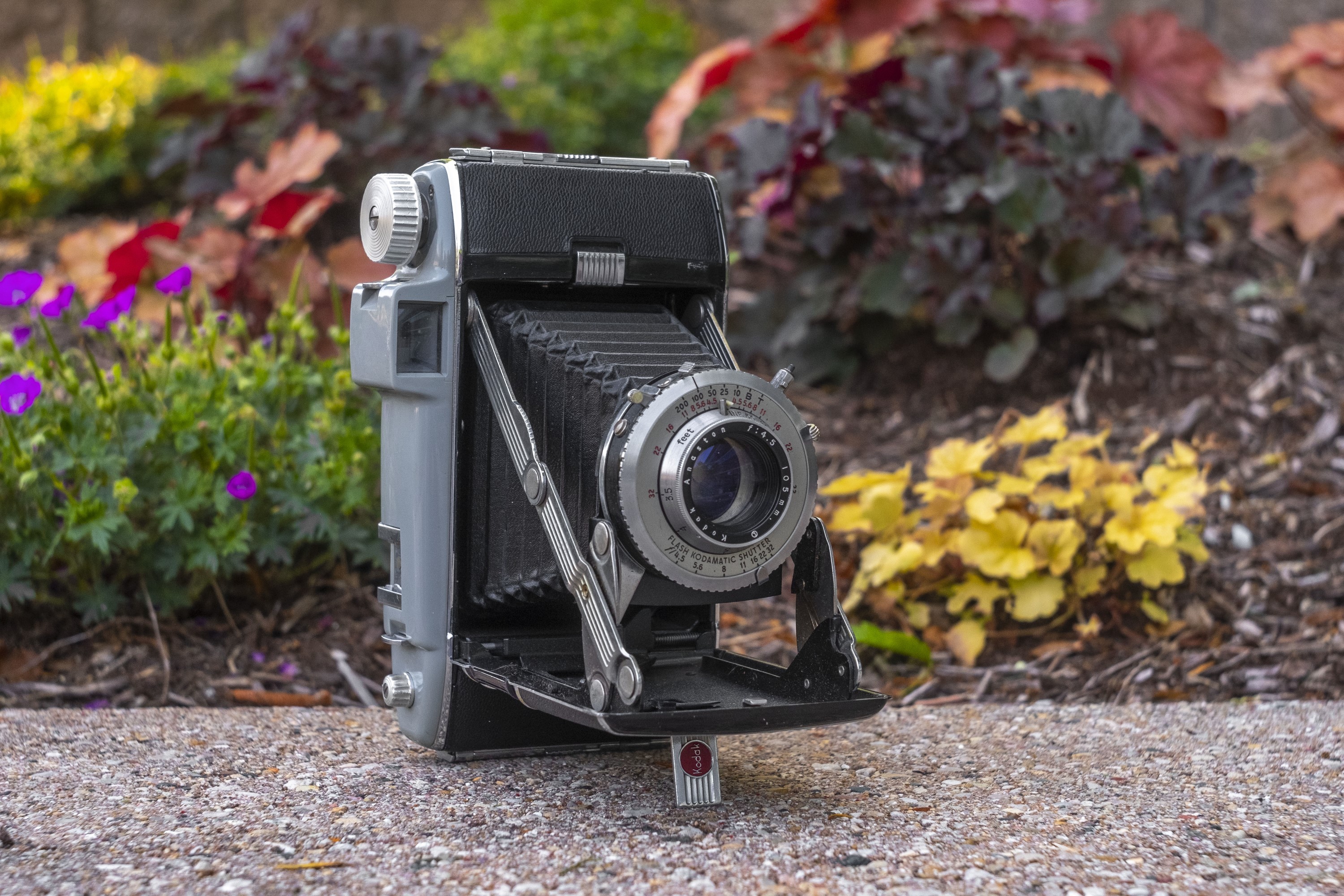

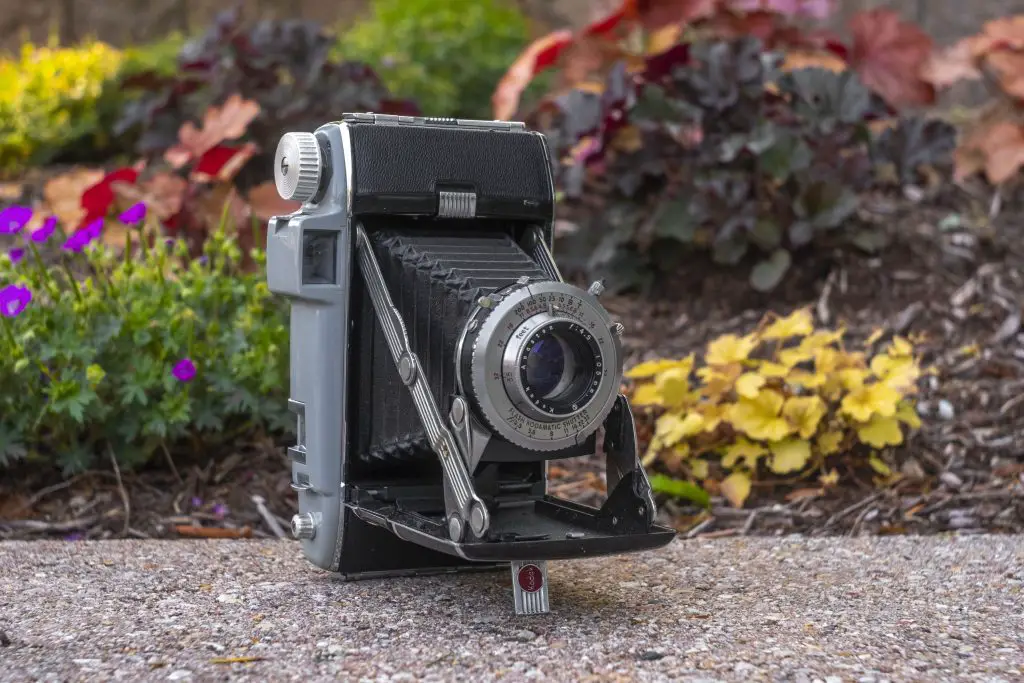
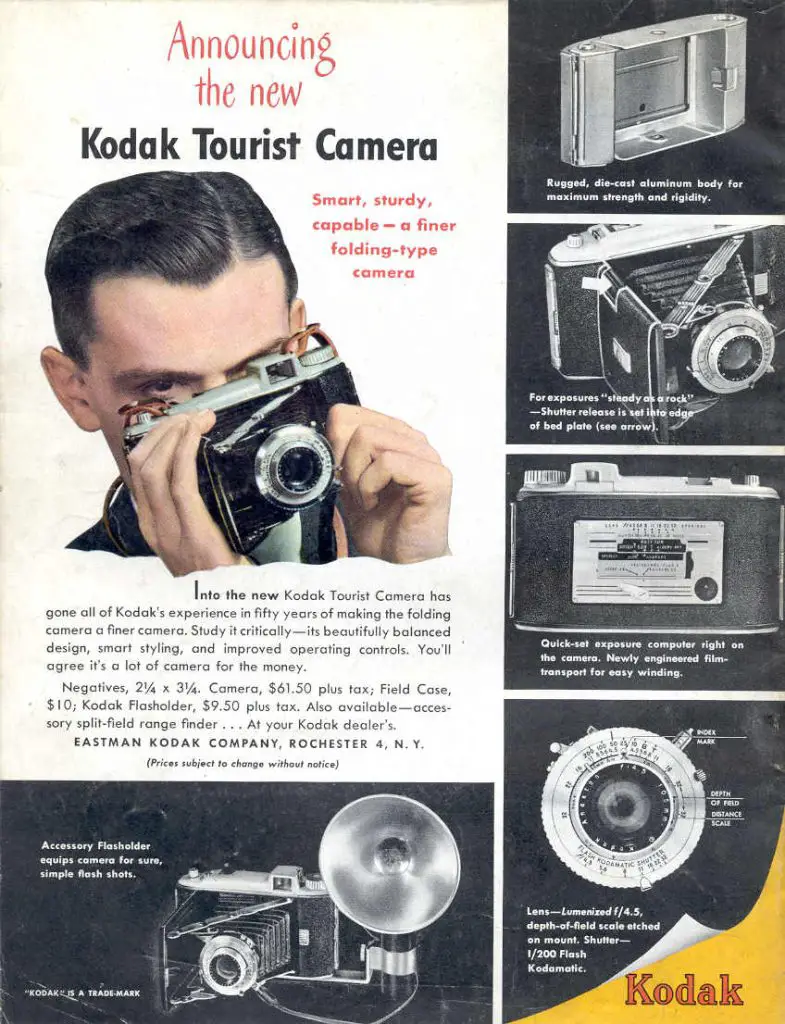

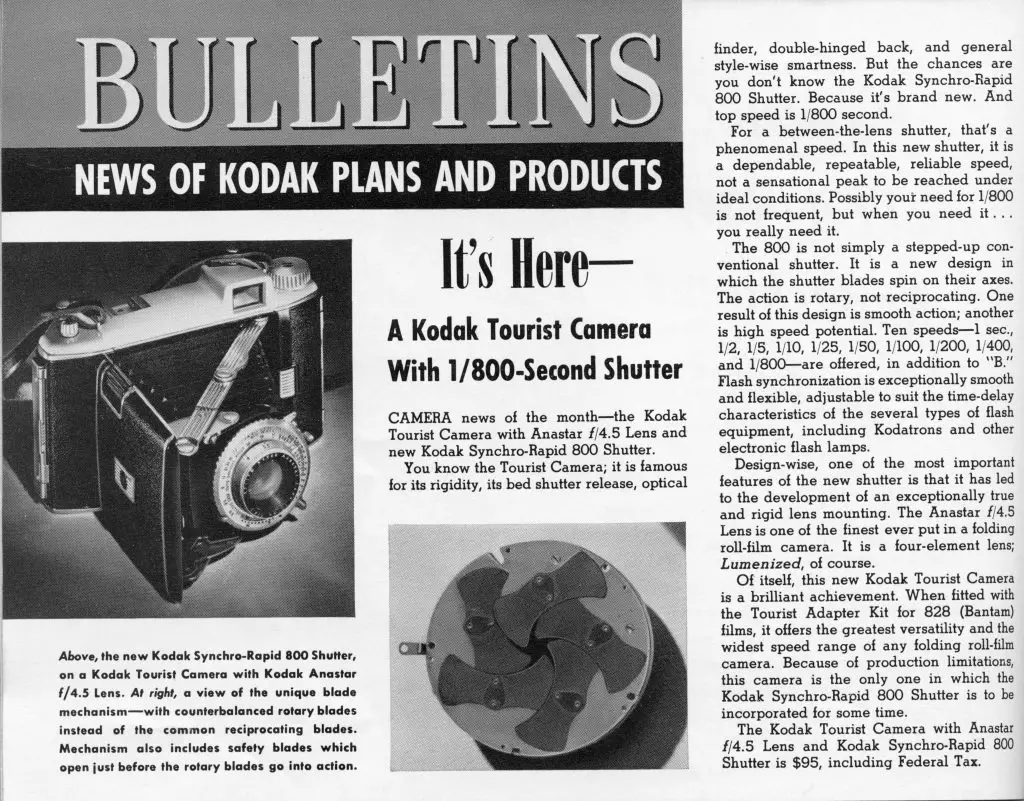










I must say that the camera was able yield some very nice images. The brick building or court house is full of detail. The hard-coated Luminized lens seems to handle your choice of color film extremely well.
Considering the small quantities / limited availability of mid-priced cameras in the immediate post war period – I’d say that the Tourist and Tourist II definitely filled a need. German camera makers hadn’t yet been able ramp up their offerings.
Here’s a YouTube photographer/machinist who eschews the “re-roll 120 onto a 620 spool” approach. He did preferred to make his Kodak Tourist take 120 roll film, period. https://www.youtube.com/watch?v=ue0jr5E0Axo
Good info, although….this guy…..is….very hard…..to listen…..to. 🙂 Another 620 camera that is commonly modified is the Medalist. There used to be some shops that specialized in adapting it to 120. For how infrequently I shoot 620 these days, it only takes me 2 minutes in a film changing bag to do one roll, so I don’t mind doing it that way.
Thanks for the informative article! Being from Rochester, New York, I am a casual collector of Kodak products (it reminds me of home). I just found a Kodak Tourist at the flea market: it’s in good shape, but not exactly like yours. It has no exposure calculator on the back, just a small round cover for the red window. On the front it says “Kodet Lens” and “Flash Kodon Shutter”. Can you tell me any more about my camera? I’d like to use it.
One more question; the Tourist I bought has a Kodak 6A close-up attachment in place over the shutter, and I can’t remove it. How is it done? Is the regular lens beneath it or do I need to find a lens for this camera? It only cost me $5.00, so if it has to be a decorative item I can live with that.
Hi Carl, answering both of your questions. The Kodet lens was the base option for the Kodak Tourist. I believe it is a two-element lens that while not going to be incredibly sharp, offers a huge depth of field making focusing the camera extremely easy. You’ll likely get images with good center sharpness, showing some vignetting and significant softness in the corners. This would work well for potraits or still lifes, as people tend to like soft edges on shots like that.
As I cover in the article, the camera uses 620 film, which means you’ll either have to buy some 620 online, or hand spool regular 120 film into 620 spools. It’s very easy to do and something you can do in a film changing bag, or just in a room with the lights off in your house.
Finally, the 6A close-up attachment is pressed on. You just need to pull it straight off. It’s not held on by screw threads. Having been there for decades, it’s likely very stiff, so you might need to pull pretty hard to get it off.
Good luck, and even if you never get a chance to shoot this camera, there are countless other options for mid 20th Century Kodaks to choose from!
Hello! I recently acquired a Kodak Tourist 2 folder. I will be re-spooling 120 onto 620 spools and had a question about advancing the film. Will the frame number in the red window correspond correctly to the 2×3 format in this camera? What numbers do I advance the film to make sure I don’t over-lap my photo’s? I’ve been shooting an Argus 75 and get the square negatives, and assume the frame numbers are meant for that size? I’m a long time 35mm film photographer, but just beginning my foray into the cool vintage stuff. I’ve searched all day trying to find an answer to this question, but can’t seem to find an answer to what seems to be a very vital question.
I enjoyed reading your above article about this camera!
Thanks, Mario
The exposure numbers on your respooled 120 will match perfectly as if you had real 620 film in there. No need to worry, it will work perfectly!
Thanks Mike! I just shot a roll while on a bike ride. I noticed it was really easy to accidentally trip the shutter while handling camera. Will this mean I got double exposures, if I had already advanced the film and I took another shot? I’ve recently started to develop my own b&w film. What fun! Will see how this roll turns out. Might of got a couple of good ones?♂️
Mario, the Tourist requires that you manually cock the shutter before you can fire the shutter. Once this is done however, then yes it can be easily tripped. For instances where you are carrying the camera around, like on a bike ride, I would not cock the shutter ahead of time, only waiting until right before you are ready to make an exposure.
I am repairing one now that has the good Anaston 4.5 lens. Most things work but the bellows is full of pinholes. I am hoping to use it as a regular shooter.